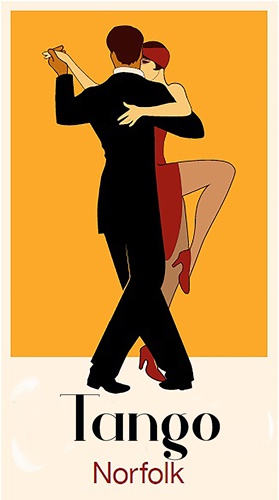MILONGA ETIQUETTE
We’re NEAT and CLEAN (Attitude, Body, Breath) whenever and wherever we dance with others. We like to DRESS UP for the milongas.
Whether dancing or moving about the room, we walk around the dance floor, rather than across it.
While finding our way to our seat we greet our friends and introduce ourselves to strangers. The milonga is a social event as well as a dance.
We Followers give MIRADA glances to prospective Leader partners, showing we are ready for an invitation by our alert body language.
We Leaders CABECEO prospective partners by catching their eye and nodding. If they meet our gaze and nod back, we hold their gaze as we go to where they are sitting to escort them to the floor. Followers and Leaders all have an unquestionable right to say “No.” If someone avoids your gaze, they are saying, “No, for now.”
We generally enter the dance floor at the corners, with the Leader catching the eye of an oncoming Leader for a nod of agreement before merging in front of the couple.
The LINE OF DANCE in tango is as for other dances and race tracks, except, no passing, no tailgating, no dawdling. Pick a lane and generally stay in it, keeping with the flow of the room. Dance with the other couples, as well as with your partner.
At the milonga we want no advice or teaching, or talking while dancing.
We take care that our dancing is compatible and safe for the milonga conditions and for our partner.
A TANDA is a grouping of three or four songs (Tango, Milonga, or Vals) with a similar sound. The CORTINA of entirely different sounding music marks the end of a tanda. We generally dance an entire tanda with our partner, unless we fear for our safety or the safety of others, or something is so off we can’t tolerate it.
We end a tanda, usually at its conclusion—or at any time we must, by saying “Thank you.” We express appreciation, if we wish, with different words, telling our partner what we liked.
Leaders accompany their partners back to where we joined them, unless they wish to go elsewhere.
When we can, as we prepare to leave we say good-bye to our friends, and thank our HOSTS and the DJ (and perhaps put something in a tip jar) for their service to the community in putting on the event.
CABECEO
The literal translation of cabeceo is ‘nod of the head’. In simple terms it is a non-verbal invitation to dance the tango from man to woman. The man looks at the woman and indicates with a movement of his head that he would like to dance. if she accepts the cabeceo, she will move towards him and they will tango; if she refuses she will look away. Watch this little clip… (source: https://www.verytangostore.com/cabeceo.html)
